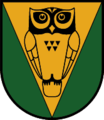Auffenstein
The Lords of Auffenstein ( Aufenstein , Ownstein , Ouwenstein ) were originally Ministeriale of the Counts of Tyrol and were first mentioned in 1173. Their heraldic animal was the eagle owl , which was called Auf in the Middle Ages . The ancestral castle Aufenstein stood near Matrei and dominated the Brennerstrasse .
history
A Heinrich von Auffenstein appeared in Innsbruck in 1234/39 , when Otto II von Andechs-Meranien 's town charter was confirmed.
Conrad III. von Auffenstein came with Meinhard II of Görz-Tirol, the grandson and successor of the last Count of Tirol, Albert III. , to Carinthia and proved itself in the suppression of the nobility uprising in 1292/93, when the Heunburger , Karlsberger and others had revolted against Meinhard, since 1286 also Duke of Carinthia. As a reward, he received the marshal's office in Carinthia and the castle and rule of Karlsberg (southwest of St. Veit an der Glan ). Konrad was able to enrich himself so considerably as a result - he soon also owned the dominions Bleiburg , Gurnitz , Heunburg , Gutenstein, etc. - that his success was attributed to dark powers and related to Wilhelm von Schärfenberg's miracle ring , which according to legend tells by the contemporary Styrian rhyming chronicler Ottokar from the Gaal , had lost his life in 1292 by his cousin Konrad von Auffenstein.
In 1304 Konrad became governor of Carinthia. After the death of his brother Heinrich II , he also inherited his Tyrolean property including his ancestral castle Auffenstein. In 1323 he founded the Poor Clare Monastery in St. Veit an der Glan , which was also to become the family burial site. In 1329 Duke Heinrich VI awarded him . an area southwest of Völkermarkt , where Konrad built Neudenstein Castle. When Heinrich VI, the last Meinhardin Duke of Carinthia, died in 1335 , Konrad ensured that the ducal dignity of Carinthia was transferred to Habsburg as smoothly as possible , but this was in sharp contrast to Countess Margarete of Tyrol , Duke Heinrich's daughter, who confiscated Konrad's Tyrolean property and had it administered in a princely manner. During the siege and capture, Auffenstein Castle was badly damaged.
Before 1341 Konrad had a hunger tower built at Nieder- Strechau Castle, in which a few decades later his own sons Friedrich and Konrad were to languish; together with Bavaria and Hungary they had an uprising against the Habsburg dukes Albrecht III. and Leopold III. instigated, but lost the decisive battle near Bleiburg in 1368 . Konrad died on Strechau in the same year, Friedrich was only released after 28 years.
With a revolt by Frederick III. von Auffenstein 1395/96 and its suppression by Governor Konrad von Kreig , head of a rival family, or rather from 1368, the Auffensteiners say goodbye to history.
coat of arms
The coat of arms shows in blue a crowned silver Auff (eagle owl), sitting on a golden (later green) mountain of three. On the helmet with blue-silver covers the shield image, the crown decorated with a peacock bump. The eagle owl was included in the municipal coat of arms of Navis , awarded in 1975 , on whose territory Auffenstein Castle is located.
Individual evidence
- ↑ Entry about Burg Aufenstein on Burgen-Austria
- ↑ Sage 1 - Sage 2
- ^ Entry about Burg Neudenstein on Burgen-Austria
- ↑ J. Siebmacher's large and general Wappenbuch, Volume I, Section 3, Part 1; The mediatized princely families in Germany; Author: OT von Hefner, M. Gritzner, Ad. M. Hildebrandt; Publication: Nuremberg: Bauer & Raspe, 1878, page 17
- ^ Eduard Widmoser: Tiroler Wappenfibel . Tyrolia-Verlag, Innsbruck 1978, ISBN 3-7022-1324-4 , p. 22 .
Web links
- Franz von Krones: Aufenstein, Konrad I. von . In: Allgemeine Deutsche Biographie (ADB). Volume 1, Duncker & Humblot, Leipzig 1875, p. 654.
- Meyers



